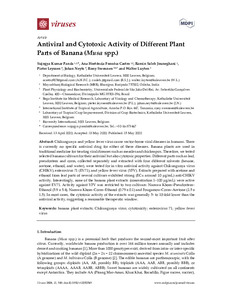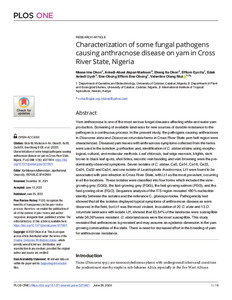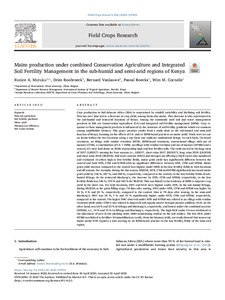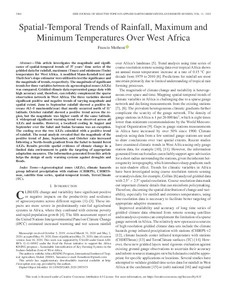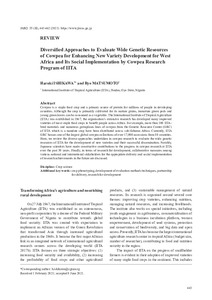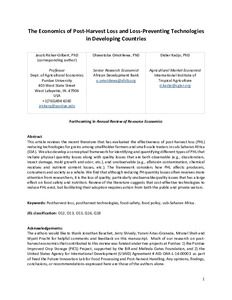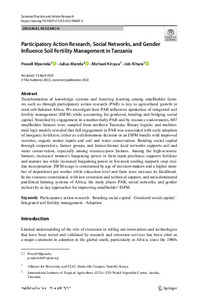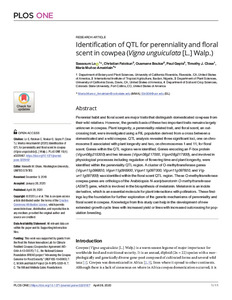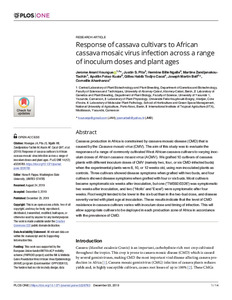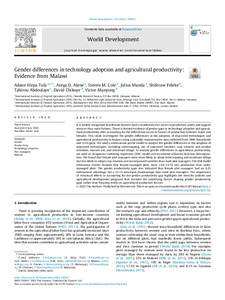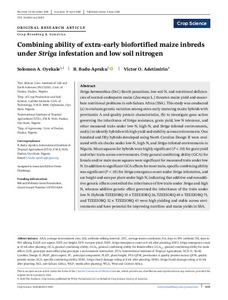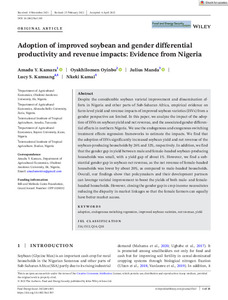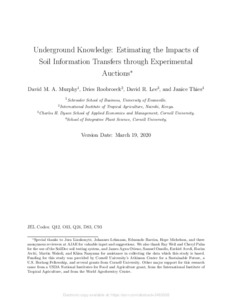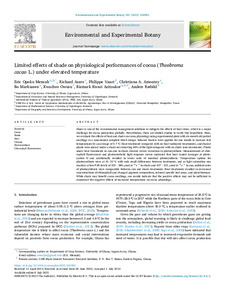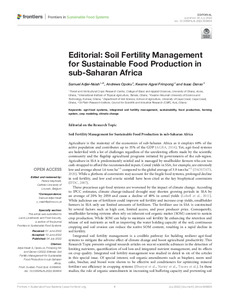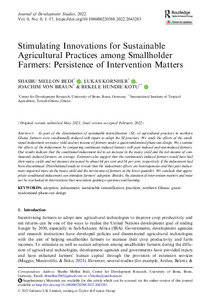Welcome to the International Institute of Tropical Agriculture Research Repository
IITA Bibliography System: Recent submissions
Now showing items 1021-1040 of 8102
-
Antiviral and cytotoxic activity of different plant parts of banana (Musa spp.)
(2020-05-15)Chikungunya and yellow fever virus cause vector-borne viral diseases in humans. There is currently no specific antiviral drug for either of these diseases. Banana plants are used in traditional medicine for treating viral diseases such as measles and chickenpox. Therefore, we tested selected banana cultivars for their antiviral but also cytotoxic properties. Different parts such as leaf, pseudostem and corm, collected separately and extracted with four different solvents (hexane, acetone, ethanol, ... -
Characterization of some fungal pathogens causing anthracnose disease on yam in Cross River State, Nigeria
(2022)Yam anthracnose is one of the most serious fungal diseases affecting white and water yam production. Screening of available landraces for new sources of durable resistance to the pathogen is a continuous process. In the present study, the pathogens causing anthracnose in Dioscorea alata and Dioscorea rotundata farms in Cross River State yam belt region were characterized. Diseased yam leaves with anthracnose symptoms collected from the farms were used in the isolation, purification and, identification ... -
Effects of traditional processing techniques on the nutritional and microbiological quality of four edible insect species used for food and feed in east Africa
(2020-05-04)Edible insects are increasingly being considered as food and feed ingredients because of their rich nutrient content. Already, edible insect farming has taken-off in Africa, but quality and safety concerns call for simple, actionable hazard control mechanisms. We examined the effects of traditional processing techniques—boiling, toasting, solar-drying, oven-drying, boiling + oven-drying, boiling + solar-drying, toasting + oven-drying, toasting + solar-drying—on the proximate composition and ... -
Maize production under combined conservation agriculture and integrated soil fertility management in the sub-humid and semi-arid regions of Kenya
(2020-09-01)Crop production in Sub-Saharan Africa (SSA) is constrained by rainfall variability and declining soil fertility. This has over time led to a decrease in crop yield, among them also maize. This decrease is also experienced in the sub-humid and semi-arid locations of Kenya. Among the commonly used soil and water management practices in SSA are Conservation Agriculture (CA) and integrated soil fertility management (ISFM). Crop response to these management practices is influenced by the existence of ... -
Spatial-temporal trends of rainfall, maximum and minimum temperatures over west Africa
(2020-05-25)This article investigates the magnitude and significance of spatial-temporal trends of 37 years' time series of the gridded data for rainfall, maximum (Tmax) and minimum (Tmin) temperature for West Africa. A modified Mann-Kendall test and Theil-Sen's slope estimator were utilized to test the significance and the magnitude of trends, respectively. The magnitude of significant trends for three variables between six agroecological zones (AEZs) was compared. Gridded climate data represented gauge data ... -
Motivational factors influencing farming practices in northern Ghana
(2020-12)Socio-economic factors that influence the adoption of management practices and technologies by farmers have received wide attention in the adoption literature, but the effects of socio-psychological farmer features such as perceptions and motivations have been analysed to a lesser extent. Using farm household survey data from three regions in northern Ghana, this study explores farmers’ motivations and perceived adoption impediments for three sustainable intensification practices (SIPs): improved ... -
Diversified approaches to evaluate wide genetic resources of cowpea for enhancing new variety development for west Africa and its social implementation by cowpea research program of IITA
(2021)Cowpea is a staple food crop and a primary source of protein for millions of people in developing countries. Although the crop is primarily cultivated for its mature grains, immature green pods and young green leaves can be consumed as a vegetable. The International Institute of Tropical Agriculture (IITA) was established in 1967; the organisation’s extensive research has developed many improved varieties of most staple food crops to benefit people across Africa. For example, more than 100 IITA-bred ... -
The economics of post-harvest loss and loss-preventing technologies in developing countries
(2022)This article reviews the recent literature that has evaluated the effectiveness of postharvest loss (PHL)-reducing technologies for grains among smallholder farmers and small-scale traders in sub-Saharan Africa. We also develop a conceptual framework for identifying and quantifying different types of PHL that include physical quantity losses along with quality losses that are both observable (e.g., discoloration, insect damage, mold growth, and odor) and unobservable (e.g., aflatoxin contamination, ... -
Participatory action research, social networks, and gender influence soil fertility management in Tanzania
(2022)Transformation of knowledge systems and fostering learning among smallholder farmers such as through participatory action research (PAR) is key to agricultural growth in rural sub-Saharan Africa. We investigate how PAR influences uptake/use of integrated soil fertility management (ISFM) while accounting for gendered, bonding and bridging social capital. Stratified by engagement in a mother-baby PAR and by resource endowments, 607 smallholder farmers were sampled from northern Tanzania. Binary ... -
Identification of QTL for perenniality and floral scent in cowpea (Vigna unguiculata [L.] Walp.)
(2020-04-28)Perennial habit and floral scent are major traits that distinguish domesticated cowpeas from their wild relatives. However, the genetic basis of these two important traits remains largely unknown in cowpea. Plant longevity, a perenniality-related trait, and floral scent, an outcrossing trait, were investigated using a RIL population derived from a cross between a domesticated and a wild cowpea. QTL analysis revealed three significant loci, one on chromosome 8 associated with plant longevity and ... -
Response of cassava cultivars to African cassava mosaic virus infection across a range of inoculum doses and plant ages
(2019-12-23)Cassava production in Africa is constrained by cassava mosaic disease (CMD) that is caused by the Cassava mosaic virus (CMV). The aim of this study was to evaluate the responses of a range of commonly cultivated West African cassava cultivars to varying inoculum doses of African cassava mosaic virus (ACMV). We grafted 10 cultivars of cassava plants with different inoculum doses of CMV (namely two, four, or six CMD-infected buds) when the experimental plants were 8, 10, or 12 weeks old, using ... -
Gender differences in technology adoption and agricultural productivity: evidence from Malawi
(2022-11)It is widely recognized that female farmers have considerably less access to productive assets and support services than male farmers. There is limited evidence of gender gaps in technology adoption and agricultural productivity after accounting for the differential access to factors of production between males and females. This study investigates the gender differences in the adoption of improved technologies and agricultural productivity in Malawi using nationally representative data collected ... -
Combining ability of extra‐early biofortified maize inbreds under Striga infestation and low soil nitrogen
(2020-07)Striga hermonthica (Del.) Benth parasitism, low soil N, and nutritional deficiencies of normal‐endosperm maize (Zea mays L.) threaten maize yield and exacerbate nutritional problems in sub‐Sahara Africa (SSA). This study was conducted (a) to evaluate genetic variation among extra‐early maturing maize hybrids with provitamin A and quality protein characteristics, (b) to investigate gene action governing the inheritance of Striga resistance, grain yield, low N tolerance, and other measured traits ... -
A high plant density and the split application of chemical fertilizer increased the grain and protein content of cowpea (Vigna unguiculata) in Burkina Faso, west Africa
(2022)In West Africa, cowpea (Vigna unguiculata) is an important source of protein for many people. To meet the protein demands, the cowpea yields per unit area and its seed protein content must be increased. We evaluated the effects of the planting density and topdressing (fertilisation) timing on the cowpea yield and its protein content. High density (HD: 40 × 40 cm) and super high density (SHD: 40 × 20 cm) plantings were the most efficient approaches for enhancing cowpea yields. Across different ... -
Adoption of improved soybean and gender differential productivity and revenue impacts: evidence from Nigeria
(2022)Despite the considerable soybean varietal improvement and dissemination efforts in Nigeria and other parts of Sub-Saharan Africa, empirical evidence on farm-level yield and revenue impacts of improved soybean varieties (ISVs) from a gender perspective are limited. In this paper, we analyze the impact of the adoption of ISVs on soybean yield and net revenue, and the associated gender differential effects in northern Nigeria. We use the endogenous and exogenous switching treatment effects regression ... -
Underground knowledge: estimating the impacts of soil information transfers through experimental auctions
(2020-10-06)Soil degradation, a serious environmental problem in many developing countries, often necessitates the use of fertilizers to improve crop yields. However, smallholders usually do not have sufficient information about their soil nutrient levels to make profit‐maximizing decisions about fertilizer usage. We conducted two‐round experimental auctions to determine whether providing information and fertilizer recommendations from inexpensive soil testing kits to farmers in western Kenya affected their ... -
Women eat more rice and banana: the influence of gender and migration on staple food choice in East Africa
(2020-04-28)An original approach was used to examine how staple food choice differs by gender and migration: this consisted of a quantitative survey (six locations with urban consumers from various economic classes (n = 123)), a qualitative in-depth interview with a subset of those consumers (n = 18), and focus group discussions (n = 13). Men and women had similar results in terms of their preferred staple food choice attributes; yet women indicated consuming more rice and banana, and men, more maize and ... -
Limited effects of shade on physiological performances of cocoa (Theobroma cacao L.) under elevated temperature
(2022)Shade is one of the recommended management solutions to mitigate the effects of heat stress, which is a major challenge for cocoa production globally. Nevertheless, there are limited studies to verify this hypothesis. Here, we evaluate the effects of heat and shade on cocoa physiology using experimental plots with six-month old potted seedlings in a randomized complete block design. Infrared heaters were applied for one month to increase leaf temperatures by an average of 5–7 ºC (heat treatment) ... -
Stimulating innovations for sustainable agricultural practices among smallholder farmers: persistence of intervention matters
(2022)As part of the dissemination of sustainable intensification (SI) of agricultural practices in northern Ghana, farmers were conditionally induced with inputs to adopt the SI practices. We study the effects of the conditional inducement on maize yield and net income of farmers under a quasi-randomised phase-out design. We examine the effects of the inducement by comparing continuous induced farmers with past induced and non-induced farmers. Our results indicate that the conditional inducement led ...

